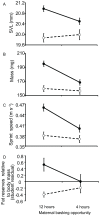Effects of maternal basking and food quantity during gestation provide evidence for the selective advantage of matrotrophy in a viviparous lizard
- PMID: 22848629
- PMCID: PMC3406071
- DOI: 10.1371/journal.pone.0041835
Effects of maternal basking and food quantity during gestation provide evidence for the selective advantage of matrotrophy in a viviparous lizard
Abstract
The evolution of matrotrophy (i.e., direct supply of nutrients by the mother during gestation) may be associated with high maternal energy availability during gestation. However, we lack knowledge about the selective advantages of matrotrophic viviparity (live-bearing) in reptiles. In reptiles, the interaction between body temperature and food intake affect maternal net energy gain. In the present study, we examined the effects of basking and food availability (2 by 2 factorial design) during gestation on offspring phenotype in a matrotrophic viviparous lizard (Pseudemoia entrecasteauxii). Subsequently, we investigated if the maternal effects were context-dependent using offspring growth rate as an indicator of the adaptive significance of matrotrophy. Offspring were exposed either to the same thermal conditions as their mothers experienced or to thermal conditions different from those experienced by their mothers. We provide the first evidence that an interaction between maternal thermal and maternal food conditions during gestation strongly affects offspring phenotype, including date of birth, body size and performance ability, which affect offspring fitness. Offspring growth rate was dependent on offspring thermal conditions, but was not influenced by maternal effects or offspring sex. Matrotrophic viviparity provided gravid females with the means to enhance offspring fitness through greater energetic input to offspring when conditions allowed it (i.e., extended basking opportunity with high food availability). Therefore, we suggest that selective advantages of matrotrophic viviparity in P. entrecasteauxii may be associated with high maternal energy availability during gestation.
Conflict of interest statement
Figures



References
-
- Mousseau TA, Fox CW (1998) Maternal Effects as Adaptations. New York: Oxford University Press.
-
- Galloway LF (2005) Maternal effects provide phenotypic adaptation to local environmental conditions. New Phytol 166: 93–99 doi: 10.1111/j.1469-8137.2004.01314.x. - DOI - PubMed
-
- Lindholm AK, Hunt J, Brooks R (2006) Where do all the maternal effects go? Variation in offspring body size through ontogeny in the live-bearing fish Poecilia parae . Biol Letters 2: 586–589 doi: 10.1098/rsbl.2006.0546. - DOI - PMC - PubMed
-
- Wapstra E, Uller T, While GM, Olsson M, Shine R (2010) Giving offspring a head start in life: field and experimental evidence for selection on maternal basking behaviour in lizards. J Evol Biol 23: 651–657 doi: 10.1111/j.1420-9101.2009.01924.x. - DOI - PubMed
Publication types
MeSH terms
LinkOut - more resources
Full Text Sources

